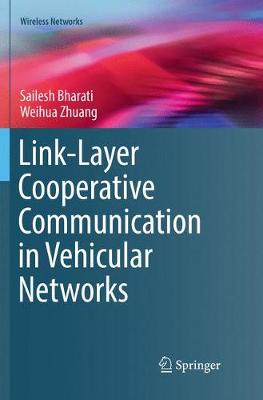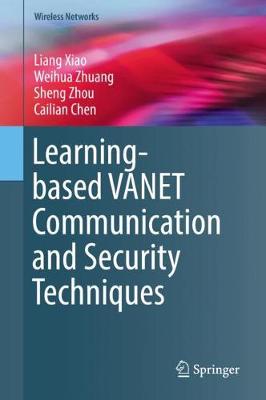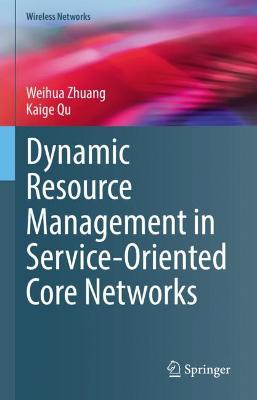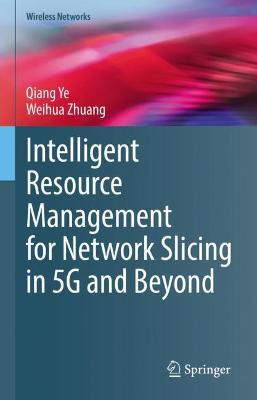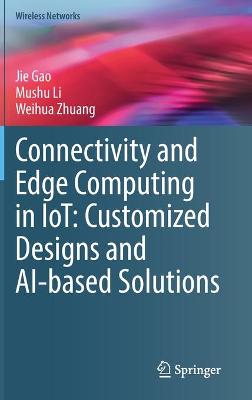Wireless Networks
6 total works
Link-Layer Cooperative Communication in Vehicular Networks
by Sailesh Bharati and Weihua Zhuang
This book presents link-layer cooperative frameworks to improve transmission reliability and network throughput of distributed TDMA MAC protocols in vehicular ad hoc networks (VANETs). The main objective of this book is to present link-layer node cooperation schemes to enhance the link-layer performance of vehicular networks, in terms of reliability...
Read moreThis book presents link-layer cooperative frameworks to improve transmission reliability and network throughput of distributed TDMA MAC protocols in vehicular ad hoc networks (VANETs). The main objective of this book is to present link-layer node cooperation schemes to enhance the link-layer performance of vehicular networks, in terms of reliability and system throughput. The authors present approaches proposed for the medium access control (MAC) and node cooperation in VANETs. The authors also cover cooperative ADHOC MAC for point-to-point communication between a pair of source and destination nodes, and cooperative relay broadcasting for broadcast services in this book. The performance of node cooperation frameworks is evaluated via mathematical analysis and computer simulations, in comparison with distributed TDMA MAC protocols without cooperation. The proposed node cooperation frameworks enhance the performance of distributed TDMA MAC and make it more robust to tackle the dynamic networking conditions in VANETs. Furthermore, with cooperation enabled transmission, the performance of distributed TMDA MAC is more suitable to support the wide range of mobile applications and their strict service requirements which is discussed in this book.
The proposed node cooperation schemes and distributed cooperation decisions can be extended to wireless systems other than distributed TDMA MAC, such as cellular communication, for vehicular communications introduced in this book. This book is useful for researchers from academia and industry, as well as advanced level students interested in vehicular communication networks. It is also useful for professionals and engineers developing applications that use cooperative wireless communication systems.
Learning-based VANET Communication and Security Techniques
by Liang Xiao, Weihua Zhuang, Sheng Zhou, and Cailian Chen
This timely book provides broad coverage of vehicular ad-hoc network (VANET) issues, such as security, and network selection. Machine learning based methods are applied to solve these issues. This book also includes four rigorously refereed chapters from prominent international researchers working in this subject area. The material serves...
Read moreThis timely book provides broad coverage of vehicular ad-hoc network (VANET) issues, such as security, and network selection. Machine learning based methods are applied to solve these issues. This book also includes four rigorously refereed chapters from prominent international researchers working in this subject area. The material serves as a useful reference for researchers, graduate students, and practitioners seeking solutions to VANET communication and security related issues. This book will also help readers understand how to use machine learning to address the security and communication challenges in VANETs.
Vehicular ad-hoc networks (VANETs) support vehicle-to-vehicle communications and vehicle-to-infrastructure communications to improve the transmission security, help build unmanned-driving, and support booming applications of onboard units (OBUs). The high mobility of OBUs and the large-scale dynamic network with fixed roadside units (RSUs) make the VANET vulnerable to jamming.The anti-jamming communication of VANETs can be significantly improved by using unmanned aerial vehicles (UAVs) to relay the OBU message. UAVs help relay the OBU message to improve the signal-to-interference-plus-noise-ratio of the OBU signals, and thus reduce the bit-error-rate of the OBU message, especially if the serving RSUs are blocked by jammers and/or interference, which is also demonstrated in this book.
This book serves as a useful reference for researchers, graduate students, and practitioners seeking solutions to VANET communication and security related issues.
Safety Message Broadcast in Vehicular Networks
by Yuanguo Bi, Haibo Zhou, Weihua Zhuang, and Hai Zhao
Dynamic Resource Management in Service-Oriented Core Networks
by Weihua Zhuang and Kaige Qu
Network slicing is enabled by the software defined networking (SDN) and network function virtualization (NFV) paradigms. For a network slice with a target traffic load, the E2E service delivery is enabled by virtual network function (VNF) placement and traffic routing with static resource allocations. When data traffic enters the network, the traffic load is dynamic and can deviate from the target value, potentially leading to QoS performance degradation and network congestion. Data traffic has dynamics in different time granularities. For example, the traffic statistics (e.g., mean and variance) can be non-stationary and experience significant changes in a coarse time granularity, which are usually predictable. Within a long time duration with stationary traffic statistics, there are traffic dynamics in small timescales, which are usually highly bursty and unpredictable. To provide continuous QoS performance guarantee and ensure efficient and fair operation of the network slices over time, it is essential to develop dynamic resource management schemes for the embedded services in the presence of traffic dynamics during virtual network operation. Queueing theory is used in system modeling, and different techniques including optimization and machine learning are applied to solving the dynamic resource management problems.
Based on a simplified M/M/1 queueing model with Poisson traffic arrivals, an optimization model for flow migration is presented to accommodate the large-timescale changes in the average traffic rates with average E2E delay guarantee, while addressing a trade-off between load balancing and flow migration overhead. To overcome the limitations of Poisson traffic model, the authors present a machine learning approach for dynamic VNF resource scaling and migration. The new solution captures the inherent traffic patterns in a real-world traffic trace with non-stationary traffic statistics in large timescale, predicts resource demands for VNF resource scaling, and triggers adaptive VNF migration decision making, to achieve load balancing, migration cost reduction, and resource overloading penalty suppression in the long run. Both supervised and unsupervised machine learning tools are investigated for dynamic resource management. To accommodate the traffic dynamics in small time granularities, the authors present a dynamic VNF scheduling scheme to coordinate the scheduling among VNFs of multiple services, which achieves network utility maximization with delay guarantee for each service. Researchers and graduate students working in the areas of electrical engineering, computing engineering and computer science will find this book useful as a reference or secondary text. Professionals in industry seeking solutions to dynamic resource management for 5G and beyond networks will also want to purchase this book.
Intelligent Resource Management for Network Slicing in 5G and Beyond
by Qiang Ye and Weihua Zhuang
This book provides a timely and comprehensive study of developing efficient network slicing frameworks in both 5G wireless and core networks. It also presents protocol stack layer perspectives, which includes virtual network topology design, end-to-end delay modeling, dynamic resource slicing, and link-layer and transport-layer protocol customization.
This book...
Read moreThis book provides a timely and comprehensive study of developing efficient network slicing frameworks in both 5G wireless and core networks. It also presents protocol stack layer perspectives, which includes virtual network topology design, end-to-end delay modeling, dynamic resource slicing, and link-layer and transport-layer protocol customization.
This book provides basic principles, concepts and technologies for communication, computing and networking. Optimization and queueing analysis techniques are applied to solving different problems for network slicing illustrated in this book as well.
Researchers working in the area of network slicing in 5G networks and beyond, and advanced-level students majoring in electrical engineering, computer engineering and computer science will find this book useful as a reference or secondary textbook. Professionals in industry seeking solutions to resource management for 5G networks and beyond will also want to purchase this book.
Connectivity and Edge Computing in IoT: Customized Designs and AI-based Solutions
by Jie Gao, Mushu Li, and Weihua Zhuang
This book covers connectivity and edge computing solutions for representative Internet of Things (IoT) use cases, including industrial IoT, rural IoT, Internet of Vehicles (IoV), and mobile virtual reality (VR). Based on their unique characteristics and requirements, customized solutions are designed with targets such as supporting massive connections or...
Read moreThis book covers connectivity and edge computing solutions for representative Internet of Things (IoT) use cases, including industrial IoT, rural IoT, Internet of Vehicles (IoV), and mobile virtual reality (VR). Based on their unique characteristics and requirements, customized solutions are designed with targets such as supporting massive connections or seamless mobility and achieving low latency or high energy efficiency. Meanwhile, the book highlights the role of artificial intelligence (AI) in future IoT networks and showcases AI-based connectivity and edge computing solutions.
The solutions presented in this book serve the overall purpose of facilitating an increasingly connected and intelligent world. The potential benefits of the solutions include increased productivity in factories, improved connectivity in rural areas, enhanced safety for vehicles, and enriched entertainment experiences for mobile users. Featuring state-of-the-art research in the IoT field, this book can help answer the question of how to connect billions of diverse devices and enable seamless data collection and processing in future IoT. The content also provides insights regarding the significance of customizing use case-specific solutions as well as approaches of using various AI methods to empower IoT.
This book targets researchers and graduate students working in the areas of electrical engineering, computing engineering, and computer science as a secondary textbook or reference. Professionals in industry who work in the field of IoT will also find this book useful.
